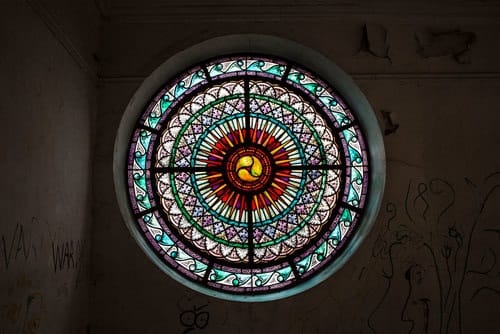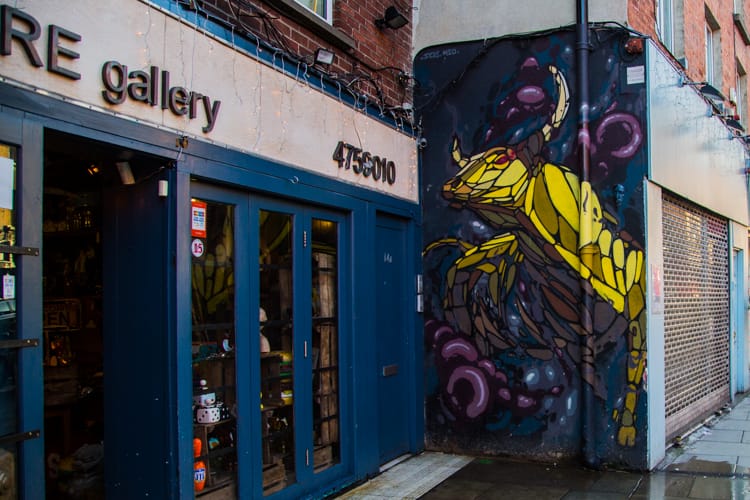What’s the best way to tell area residents about plans for a new asylum shelter nearby?
The government should tell communities directly about plans for new asylum shelters, some activists and politicians say.
A reader’s question prompted us to research a strip of buildings on Camden Street, and learn about their stained-glass history and Weatherspoons-hotel future.

The difference between two sides of the road on this stretch of Camden Street is striking. On the left, the Bleeding Horse pub and the Camden Court Hotel. Both are modern and well-kept, with gleaming windows.
Across the road: dereliction and neglect, gaudy leftover signs, and an ugly metal grate masking a lone circular stained-glass window.
You might have noticed that stretch of rundown-ness on the west side of Camden Street and wondered if it’ll ever be spruced up. One of our readers, Lara Hickey, did too, and asked: what’s up with that disused building with the beautiful window? Who owns it?
So, we said we’d find out for her.
Turns out, that strip of the street is under new ownership.
A year ago, British mega-pub chain JD Wetherspoons bought numbers 1, 2, 3, 4 and 5 Camden Street Upper, as well as numbers 49, 50 and 51 Camden Street Lower. (They’re all in a row.)
The pub giant is plotting its first hotel in Ireland. Plans for the site are still being decided, but it will include a Wetherspoons pub, as well as a hotel with upward of 100 bedrooms, says spokesman Eddie Gershon.
The previous owners got planning permission to refurbish the protected buildings, and the council supported an application for a 165-bedroom hotel, restaurant, bar and retail space. But Wetherspoons said it will submit a new application to Dublin City Council in the new year.
Wetherspoons has a reputation as a modern chain with a nose for historic buildings. That is one of the reasons it picked this site, said Gershon.
Earlier this year, a Wetherspoons popped up in the protected Old Borough pub in Swords after €2.8-million refurbishment. Locals were happy, reported the North County Leader at the time.
As part of the chain’s €4 million investment, the Camden Street structures will also be refurbished – including the circular stained-glass window, which is so special that it’s protected in its own right.

Rebecca Hawe, a student of Fine Art Media at National College of Art and Design (NCAD), will be glad to see the window in all its glory.
She’s been trying to gain access to the building so she can photograph the window with light shining through it.
After passing the window on her way to college every day, Hawe decided to base her final-year project on it – a great excuse to discover more about its history.
“I think people just ignore it, or just don’t realise it’s there,” she says.
The window dates back to the days of the Earley & Co Studios, which set up here in 1852. Architect Augustus Welby Pugin, famous for his Gothic Revival style and his work on the Palace of Westminster, trained the two founding brothers, Thomas and John Earley.
They made their names as church decorators. Altar design, metal carving, stone carving, sculpting, painting and, of course, stained-glass-window design were among their trades.
Examples of their stained glass pieces can be seen in churches around Dublin. There are Earley windows in St Teresa’s on Clarendon Street, in Whitefriar Street Church, and in St Patrick’s Church in Ringsend, to name a few places.
And what about Camden Street’s work of art in disguise?
“To my knowledge, my great-grandfather, John Earley, did that,” says Michael Earley, who can remember the studio as a schoolboy when his father, Leo, worked there.
He can recall when the studio was still going strong. “It had 100 employees in its heyday, including the biggest stained-glass display studio in Ireland,” he says.
Famous Irish painter and stained-glass artist Evie Hone would come to Earley Studios to use the kiln, because hers wasn’t always large enough, says Earley. Okay, that might be a myth, he says.
But he does know for sure that the father of Easter Rising leader Padraig Pearse worked as a sculptor for the studios, and writer Brendan Behan worked there as a painter too.
Earley Studios closed in 1975 after being run by the Earley family for more than a century. “It essentially ran out of work and the company went bankrupt,” says Michael Earley.

Earley Studios may have closed, but the legacy lives on.
Michael Earley’s son James has created street art for 18 years.
In recent years, he has researched his family’s stained-glass work. “Churches in the city centre would have a lot of them,” he says. “Looking at them all, it’s helped inform the artwork I create now.”
James began painting his signature stained-glass style in 2009.
In Dublin, you can see his work on the fencing surrounding derelict land on South Richmond Street where a bull in blues and greys, with muscles and sinews like fragments of glass, charges in the direction of the Bernard Shaw pub.
This style can be seen throughout his graffiti pieces around Dublin, including another bull, this one yellow and brown, on Camden Street, and in his screen prints too. “All my personal work is done in that style,” he says.
His Dad, Michael, even sees the influence of stained glass in his son’s commissioned work on the colourful facade of the Blooms Hotel, on the edge of Temple Bar.
James Earley would like to see Camden Street’s stained-glass window restored as part of the Wetherspoons development, serving as a reminder of his family’s long tradition of stained-glass artistry.
We’ve been asking readers what they would like us to write about, and lots of you have responded, including Lara Hickey who asked the question that led to this story.
If you’ve got a question you wanted answered, a building explored or a person profiled, let us know through the form in the right sidebar, or with an email to info@dublininquirer.com.
Get our latest headlines in one of them, and recommendations for things to do in Dublin in the other.